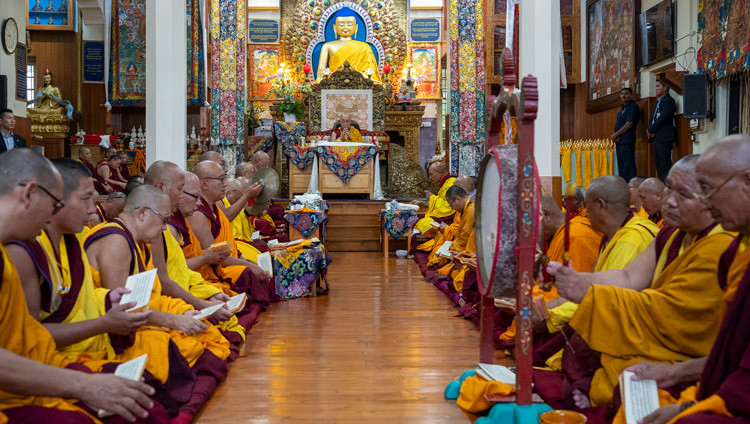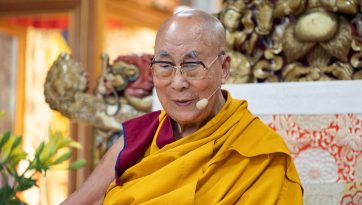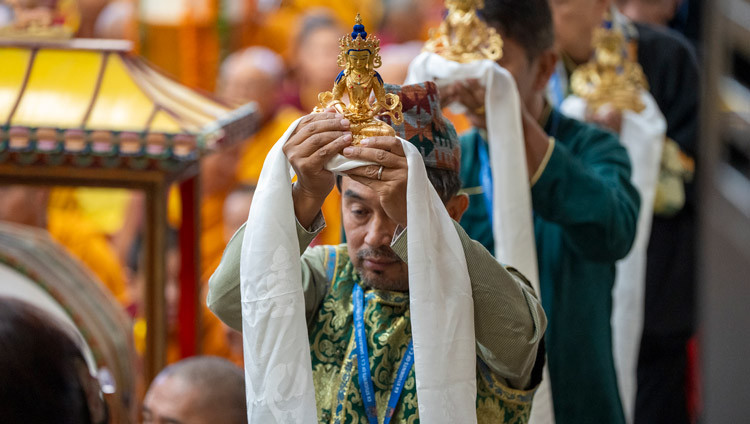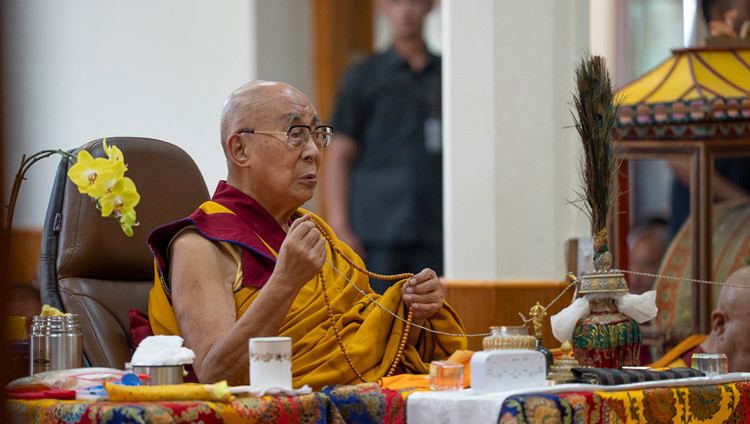‘Eight Verses for Training the Mind’ & ‘Thirty-seven Practices of a Bodhisattva’
December 27, 2020
Thekchen Chöling, Dharamsala, HP, India – Invited by the Tibetan Communities of North America to teach ‘Eight Verses for Training the Mind’ & ‘Thirty-seven Practices of a Bodhisattva’ this morning, His Holiness the Dalai Lama arrived almost fifteen minutes early. Representative Ngodup Tsering introduced the event in Tibetan. He thanked His Holiness on behalf of Tibetans in North America for the opportunity to hear him teach and answer questions. He also drew attention to the Tibetan Policy and Support Act of 2020 (TPSA) that was passed recently. He noted that many Tibetans in North America are doing well in their studies and work. Finally, he asked His Holiness to live 125 years as Trulshik Rinpoché had predicted he could.
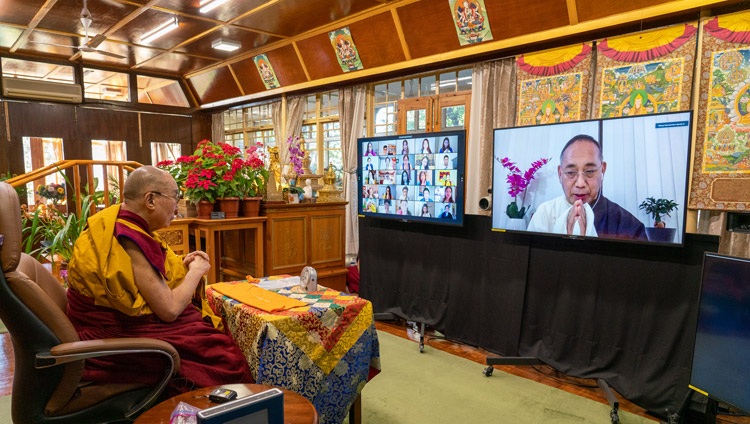
His Holiness’s opening words were: “Today, I’m happy to have this opportunity to talk to Tibetans in North America. These days it’s difficult for me to travel far because of my age, but teaching like this over the internet from here in Dharamsala is relatively easy.
“We are Tibetans from the Land of Snow. Before the reign of Songtsen Gampo we lived as nomads like the Mongolians. He married a Chinese princess who brought the precious Jowo statue to Tibet. His relations with the Chinese were close, but when it came to designing a Tibetan form of writing, he chose to model it on the Indian Devanagari alphabet.
“In the eighth century, although relations with China were still close, King Trisong Detsen preferred to look to India as a source of Buddhist teachings. He invited Shantarakshita to Tibet. One of his key suggestions was that, rather than struggling to learn Pali and Sanskrit to read Buddhist literature, Tibetans should translate it into Tibetan. Consequently, the collections of the Kangyur and Tengyur were created.
“What Shantarakshita introduced to Tibet was the Nalanda Tradition, which involved not only the Middle Way (Madhyamaka) philosophy, but also rigorous logic and epistemology. Tibetan Buddhism is the only tradition to have kept alive the study of the Perfection of Wisdom, the Middle Way, logic and epistemology, Higher Knowledge (Abhidharma) and Monastic Discipline (Vinaya). Eventually this approach was conveyed to Mongolia by, among others, the Third Dalai Lama.
“These days, all that physically remains of the great centre of learning known as Nalanda University is a ruin. I remember once making a pilgrimage there and reciting Chandrakirti’s ‘Entering into the Middle Way’ out of respect for the traditions that prevailed there that we Tibetans have kept alive.
“From simple nomads we have transformed ourselves into rigorous students of Buddhism through extensive study, reflection and meditation on what the Buddha taught. Followers of the Pali Tradition in Sri Lanka, Thailand and Burma follow the Buddha’s teaching on the basis of scriptural authority. We follow the Buddha’s advice to be sceptical and to question. He told us, ‘O monks and scholars, as gold is tested by burning, cutting and rubbing, examine my words thoroughly and accept them only then — not just out of respect for me.’ ”
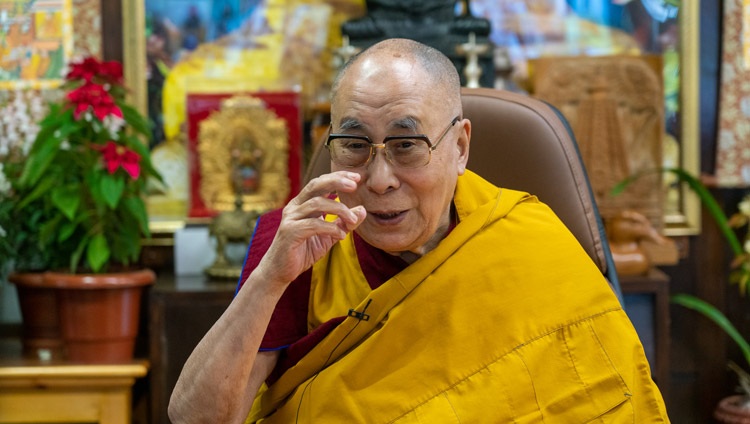
In stressing the importance of studying the Perfection of Wisdom, the Middle Way, as well as logic, His Holiness quoted a verse from the end of Chandrakirti’s ‘Entering into the Middle Way’,
This suchness just explained is most profound and terrifying, yet people with past habituation will certainly realize it;
Others, however, despite vast learning, will fail to comprehend.
Thus, seeing those other traditions as constructed by the authors’ own minds as akin to the treatises that set forth propositions on self,
Forsake admiration for treatises and systems contrary to this one. 11.55
He went on to quote further verses that indicate the logical absurdities that ensue if you assert that things have intrinsic existence.
If the intrinsic characteristics of things were to arise dependently,
things would come to be destroyed by denying it;
emptiness would then be a cause for the destruction of things.
But this is illogical, so no real entities exist. 6.34
Thus, when such phenomena are analysed,
nothing is found as their nature apart from suchness.
So, the conventional truth of the everyday world
should not be subjected to thorough analysis. 6.35
In the context of suchness, certain reasoning disallows arising
from self or from something other, and that same reasoning
disallows them on the conventional level too.
So, by what means then is your arising established? 6.36
He mentioned that he repeats these verses to himself and reflects on them daily. He also noted Chandrakirti’s effective sevenfold analysis.
A chariot cannot be said to be different from its parts;
it is not identical with the parts, nor does it possess the parts;
it is not in the parts, nor do the parts exist in it;
it is not the mere collection, nor is it the shape. 6.151
For if the mere collection constitutes the chariot,
the chariot would exist even when the parts are not assembled;
since there can be no parts without the bearer of the parts,
that shape alone is the chariot is illogical as well. 6.152
Things can’t be found to exist independently in terms of this sevenfold analysis, but they do exist by way of convention. Consequentialists (Prasangikas) say things have no ultimate existence, but do exist by way of designation. His Holiness clarified that the purpose of exploring such philosophical views is to combat our misconception of reality.
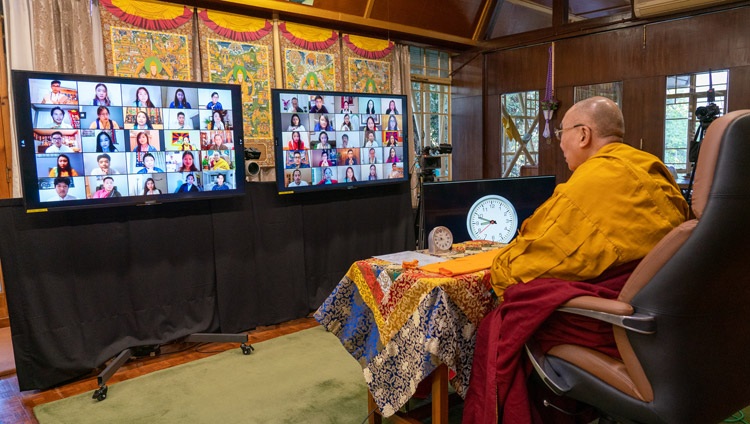
In addition to this, in his ‘Entering into the Way of a Bodhisattva’, Shantideva presents the powerful practice of exchanging self with others. He justifies it with the following declaration.
All those who suffer in the world do so because of their desire for their own happiness. All those happy in the world are so because of their desire for the happiness of others. 8/129
Why say more? Observe this distinction: between the fools who long for their own advantage and the sage who acts for the advantage of others. 8/130
For those who fail to exchange their own happiness for the suffering of others, Buddhahood is certainly impossible – how could there even be happiness in cyclic existence? 8/131
His Holiness recalled that in the past Tibetan Buddhism was referred to in some quarters as ‘lamaism’, as if it was not the real teaching of the Buddha. Since Tibetans came into exile it has become clear that they follow the Nalanda Tradition. And it is because of this, and its reliance on reason and logic, that Tibetan Buddhists have been able to enter into fruitful dialogue with modern scientists.
Among the key observations Buddhists have to make is that what disturbs our mind is the misconception that things intrinsically exist. Another is that disturbances of the mind can only be tackled by cultivating positive states of mind. The knowledge preserved in Tibetan Buddhist tradition is of such value that it is a treasure for humanity.
“We have kept our traditions alive and will continue to do so. This is something Tibetans in Tibet are also devoted to, not as a result of blind faith, but on the basis of reason.”
His Holiness ended his preliminary talk by explaining that as far as coming to North America is concerned, one of his friends has offered to make his own private plane available — but it is still a very long journey. For the time being, he said he is pleased to be able to interact with so many people over the internet.
Turning to the first of the texts he was to read, the ‘Eight Verses for Training the Mind’, His Holiness remarked that Geshé Langri Thangpa was renowned for his practice of bodhichitta. However, his concern for suffering sentient beings was such that he always wore a long face.
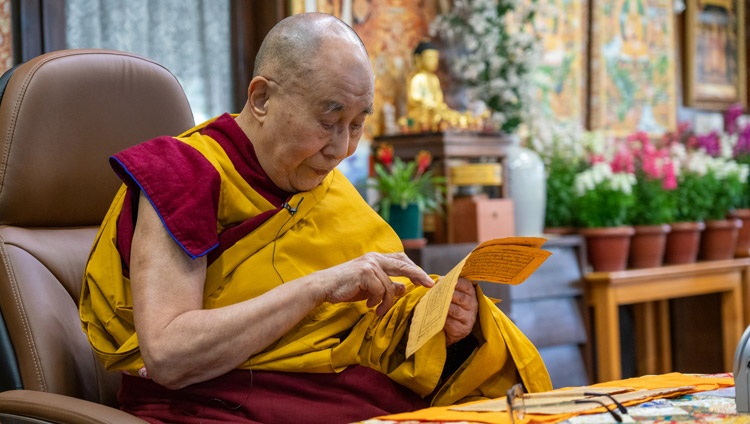
The first verse alludes to the compassionate awakening mind, the wish to liberate sentient beings from suffering. The intent of the second is to regard yourself as the lowest of all, while treating others with respect. The third suggests that whatever you do, you should not allow yourself to be carried away by mental afflictions. The fourth recommends cultivating compassion for those who react to you with anger. The fifth declares that you should offer the victory to others. The sixth and seventh verses refer to the practice of exchanging self and others — give your virtues to them and take their ill-deeds on yourself. The final verse asserts, ‘May I see all things as illusions’ — the view of emptiness — ‘and, without attachment, gain freedom from bondage’.
His Holiness spoke of how close he feels to what Nagarjuna teaches in his treatise on emptiness, ‘Fundamental Wisdom of the Middle Way’. He voiced his sense that he may have been on the edge of the gathering when Nagarjuna taught about finding that nothing has a true and independent identity, but things do exist by way of designation on the basis of worldly renown. He remarked that the ‘Eight Verses’ deal with both conventional and ultimate bodhichitta, and that he recites them every day.
The introductory verses of the ‘Thirty-seven Practices of a Bodhisattva’ observe that ‘all phenomena lack coming and going’ yet, as His Holiness had already mentioned, they exist by way of designation. He read steadily through the verses beginning with the meaning of a precious human life, the value of solitude, and impermanence. There is a reference to taking the help of spirits and others, but that they are not appropriate objects of refuge. To help others is create the causes for good fortune. There is also a reference here to the practice of equalizing and exchanging self and others.
The text mentions that seeking praise and fame can diminish your practice. It notes that what appears to you are projections of the mind, prompting His Holiness to observe that Thogmé Sangpo seems to have been a follower of the Mind Only view. There are a series of verses highlighting the practice of the six perfections. The text ends with an aspiration to constantly ask ‘What’s the state of my mind?’ and a dedication of the virtue from making such effort to enlightenment.
His Holiness reported that the copy of the text he had been reading was sent to him in Darjeeling from Tibet by Lhatsun Rinpoché. In due course he was able to request Khunu Lama Rinpoché to explain it and to give him the transmission.
Representative Ngodup Tsering invited several young Tibetans in the USA and Canada to put questions to His Holiness. The first was about how to help people suffering from incurable illness. His Holiness first expressed his admiration for those undertaking medical training. Then he pointed out that if an illness has a remedy, there’s no need to worry. But if there is no cure, worrying won’t help. When the time of death arrives, Vajrapani may remove obstacles and the Medicine Buddha may grant blessings, but you just have to die.
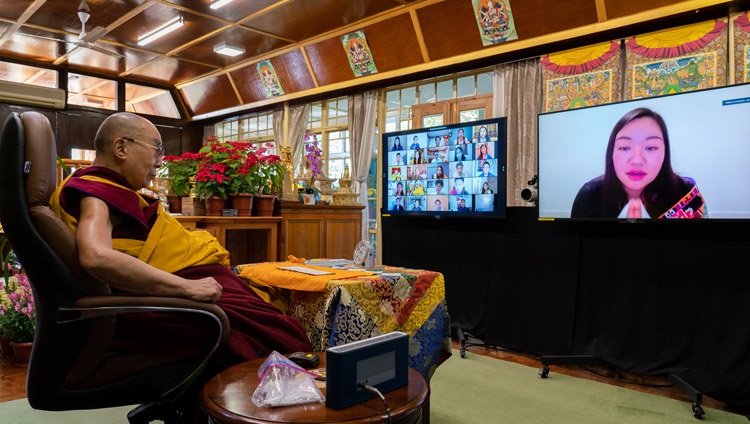
Buddhists don’t believe in an ‘atman’ or soul that goes on from life to life, they talk about the continuity of the mental continuum.
“While there’s still hope,” he added, “take what treatment there is and keep calm, preserve your peace of mind and, if you’re a Buddhist, pray to be taken care of by spiritual masters in the future.”
His Holiness set the practice of bodhichitta in the context of our being human beings who depend on our communities to survive. This is why it’s a mistake to neglect the welfare of others and why it’s important to help them whenever you can. It’s because of our dependence on others that cultivating a sense of the oneness of humanity, and a recognition that we are all the same in wanting to be happy and to avoid suffering, is so effective.
His Holiness explained that although he has retired from his political role, he considers it his responsibility to encourage the preservation of Tibetan culture and the protection of the natural environment of Tibet. People in Tibet respond by keeping the Tibetan spirit alive.
“Tibetan culture can be of benefit to the world at large,” he said. “We should not lament what we have lost, but can be proud that our traditions can be helpful to others. Books we have published here in exile on science and philosophy have reached universities in Tibet. I’ve had reports that Chinese scholars have been impressed by the scientific character of this presentation of Tibetan Buddhism. This is an example of the impact those of us in exile can have on what happens in Tibet.
“Preserving our culture and traditions is important, but so is sharing what we know with others.”
Asked his view of competition, His Holiness drew a distinction between obstructing others’ ability to succeed in order to be first, which is detrimental, and exerting yourself to get to the top to set an example for others to follow.
A young woman brought up the need for the equality of women. His Holiness told her of scientific evidence that women are more compassionate and that a mother’s love is particularly powerful. He reported writing recently to congratulate the woman Prime Minister of Finland on her appointment, as well as her choice of a largely female cabinet. Being more sensitive to the feelings of others, women can be more effective in promoting love and compassion.
Challenged to say why Australian bushfires and the covid pandemic have come about, His Holiness expressed sorrow about the large numbers of animals that have perished in fires in Australia and Brazil, which he attributed to global warming, as well as those who have lost their lives to the corona virus. He reflected that the pandemic can be viewed in terms of collective karma, but emphasised the importance of remaining optimistic and keeping your spirits up.
“No matter how ill you are, you should remain optimistic and retain your peace of mind,” His Holiness advised. “If you are treating the sick, it’s important never to lose heart and to encourage your patients to be hopeful. If you’re a Buddhist, you can recite Tara’s mantra, which I do for some time every day, praying that the pandemic will soon subside. I also recite the Muni mantra in the same way. This kind of practice can help and does no harm at all. You can also tell your patients that the Dalai Lama is praying for them.”
Asked how young Tibetans can make the world a better place to live in, His Holiness recommended giving and taking medical help, reciting mantras and responding to others with love and compassion. With regard to global warming, he warned that it may increase to such a degree that the Tibetan plateau, source of so many Asian rivers, will become arid like Afghanistan. He reflected that from a larger perspective worlds come and go, but, in the meantime, we must take greater care of our natural ecology.
In his final remarks His Holiness encouraged the Tibetans among his listeners, wherever they are, not to forget that they are Tibetan. They have Tibetan blood. They are descendants of Tibetan ancestors. They should preserve their culture and traditions with courage.
“Tibetan humility, kindness and moral standards are widely admired — please keep them alive.”
SOURCE: dalailama

